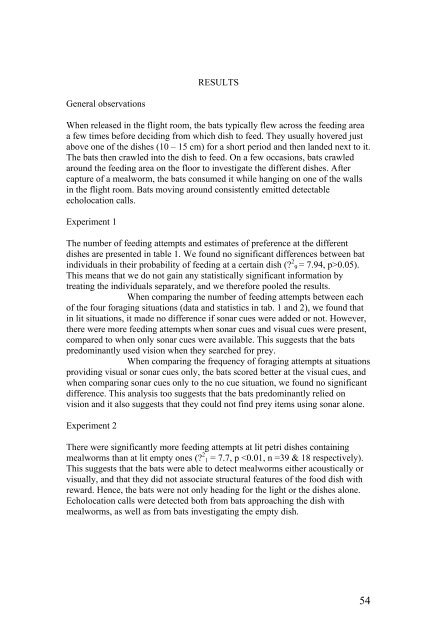Vision in echolocating bats - Fladdermus.net
Vision in echolocating bats - Fladdermus.net
Vision in echolocating bats - Fladdermus.net
Create successful ePaper yourself
Turn your PDF publications into a flip-book with our unique Google optimized e-Paper software.
General observations<br />
RESULTS<br />
When released <strong>in</strong> the flight room, the <strong>bats</strong> typically flew across the feed<strong>in</strong>g area<br />
a few times before decid<strong>in</strong>g from which dish to feed. They usually hovered just<br />
above one of the dishes (10 – 15 cm) for a short period and then landed next to it.<br />
The <strong>bats</strong> then crawled <strong>in</strong>to the dish to feed. On a few occasions, <strong>bats</strong> crawled<br />
around the feed<strong>in</strong>g area on the floor to <strong>in</strong>vestigate the different dishes. After<br />
capture of a mealworm, the <strong>bats</strong> consumed it while hang<strong>in</strong>g on one of the walls<br />
<strong>in</strong> the flight room. Bats mov<strong>in</strong>g around consistently emitted detectable<br />
echolocation calls.<br />
Experiment 1<br />
The number of feed<strong>in</strong>g attempts and estimates of preference at the different<br />
dishes are presented <strong>in</strong> table 1. We found no significant differences between bat<br />
<strong>in</strong>dividuals <strong>in</strong> their probability of feed<strong>in</strong>g at a certa<strong>in</strong> dish (? 2 9 = 7.94, p>0.05).<br />
This means that we do not ga<strong>in</strong> any statistically significant <strong>in</strong>formation by<br />
treat<strong>in</strong>g the <strong>in</strong>dividuals separately, and we therefore pooled the results.<br />
When compar<strong>in</strong>g the number of feed<strong>in</strong>g attempts between each<br />
of the four forag<strong>in</strong>g situations (data and statistics <strong>in</strong> tab. 1 and 2), we found that<br />
<strong>in</strong> lit situations, it made no difference if sonar cues were added or not. However,<br />
there were more feed<strong>in</strong>g attempts when sonar cues and visual cues were present,<br />
compared to when only sonar cues were available. This suggests that the <strong>bats</strong><br />
predom<strong>in</strong>antly used vision when they searched for prey.<br />
When compar<strong>in</strong>g the frequency of forag<strong>in</strong>g attempts at situations<br />
provid<strong>in</strong>g visual or sonar cues only, the <strong>bats</strong> scored better at the visual cues, and<br />
when compar<strong>in</strong>g sonar cues only to the no cue situation, we found no significant<br />
difference. This analysis too suggests that the <strong>bats</strong> predom<strong>in</strong>antly relied on<br />
vision and it also suggests that they could not f<strong>in</strong>d prey items us<strong>in</strong>g sonar alone.<br />
Experiment 2<br />
There were significantly more feed<strong>in</strong>g attempts at lit petri dishes conta<strong>in</strong><strong>in</strong>g<br />
mealworms than at lit empty ones (? 2 1 = 7.7, p


